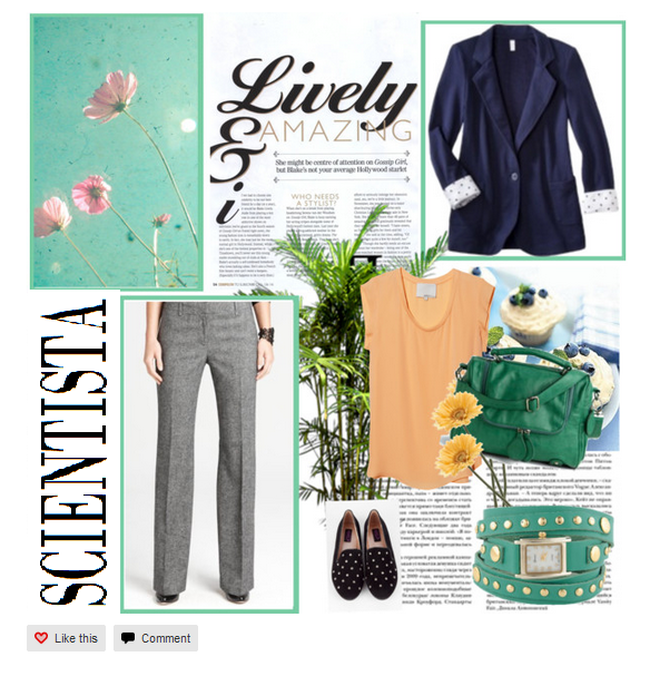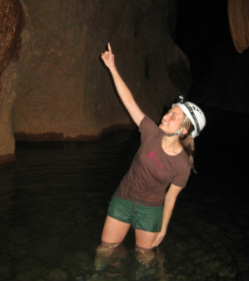How to Dress... For the Lab!
Don't know how to dress for research? Read our fashion tips and our suggested outfits!
 Hair Tip: Keep it tied back
April 18, 2012
By Natalie Punt Deciding what to wear is a question many women face on a daily basis. Deciding what to wear to a new job or internship can be even more challenging. Many people take their dress cues from what others are wearing in their work environment. However, what if the environment you are about to enter is fraught with strict dress codes, strange neck ties and trousers, and little precedent for women? The laboratory setting can be a strange place to dress for, as it is occupied by a broad spectrum of ethnicities, peer expectations and safety codes. In addition, the public perception of “the scientist” often portrays a middle-aged, quirky, unkempt workaholic male. Females entering the laboratory may have a tough time finding a style that is simultaneously compatible with lab members and maintains a unique sense of self. Here are my tips on how to do just that! 1. Following Safety Code The lab environment is unique in that the only dress code requirement is through the Occupational Safety and Health Administration (OSHA) and in general, individuals are able to dress in however they feel fit. However, the lab can be a politically heated environment and opportunities for misinformed judgments should be avoided. Most, if not all labs have dress code requirements for safety. Hair that looks great down can easily become singed by Bunson burners or trapped in machines. Braids are a smart and chic alternative as well as loose buns and neat up-does. If long hair is not your flavor, short -styled bobs impart a sophisticated flair. Sandals and open toes shoes look great outside of the lab. Inside of the lab, exposed toes are a magnet for chemical spills. Use lab work as an excuse to go shoe shopping for closed-toe shoes. Loafers can be surprisingly cute and tall riding boots add style to any workbench. Short hemlines have their time and place, and lab regulations strictly regulate shorts, skirts and short dresses. Exposed skin is at risk for contact with hazardous material and burns. Minimize the amount of skin exposed by keeping hemlines below the knee. Leggings may be a feasible compromise to keep short hemlines. 2. Dressing comfortably Once OSHA’s requirements are met then consider what is comfortable for you. Most scientists work long hours, thus wearing comfortable clothes is necessary. However, being comfortable should not be an excuse for being sloppy or slovenly. Making an effort to maintain your individuality and style allows you to stand out from the crowd and be recognized as a Scientista with high standards. 3. Putting the “a” in Scientista For many women, dressing femininely allows them to maintain a sense of self in a male dominated world. A light touch such as soft jackets, scarves and blouses describes feminity without blasting it out with high heels, tight shirts and loud patterns. Similarly, loud or bright make-up can be distracting and confer a sense of unprofessionalism. Save that bright lipstick and smokey-eye look for a night out. Instead, we recommend going with a clean look. A bit of mascara, light foundation, and a tinted lip balm can make you look fresh and kempt without looking over the top. Ask if your lab has contraindications against nail polish. Some clinical laboratories or those that interact with patients can have strict regulations regarding makeup, nail polish and jewelry. Similarly, if you perform sensitive experiments it would be beneficial to understand if your lotion, makeup or perfume could potentially interfere. Though not necessarily fair, there still exists the sentiment/stigma that women who “overdress” in the workplace are not serious or are incapable of producing quality work. By dressing tastefully, yet appropriately, women can avoid unfortunate judgments. Many clothing brands offer feminine yet work appropriate clothing that allow individuals to express their sense of self will looking professional and chic. An individual’s style is an expression of self. However, when dressing for the lab environment a self-check must be performed to make sure you are not broadcasting an unintended message. Be comfortable and be yourself while still looking professional. Sources: Science and Technology: Public Attitudes and Public Understanding. http://www.nsf.gov/statistics/seind02/c7/c7s3.htm (http://www.nsf.gov) Click on the photo for more spring lab outfits handpicked by our fashionista scientista, Elizabeth Mrema! About the Fashionista
About the Blogger
Comments?
|
The Scientista Foundation, Inc. All Rights Reserved © 2011-2021 | Based in NY | contact@scientistafoundation.org
The Network for Pre-Professional Women in Science and Engineering
The Scientista Foundation is a registered 501(c)(3) -- Donate!
The Network for Pre-Professional Women in Science and Engineering
The Scientista Foundation is a registered 501(c)(3) -- Donate!



